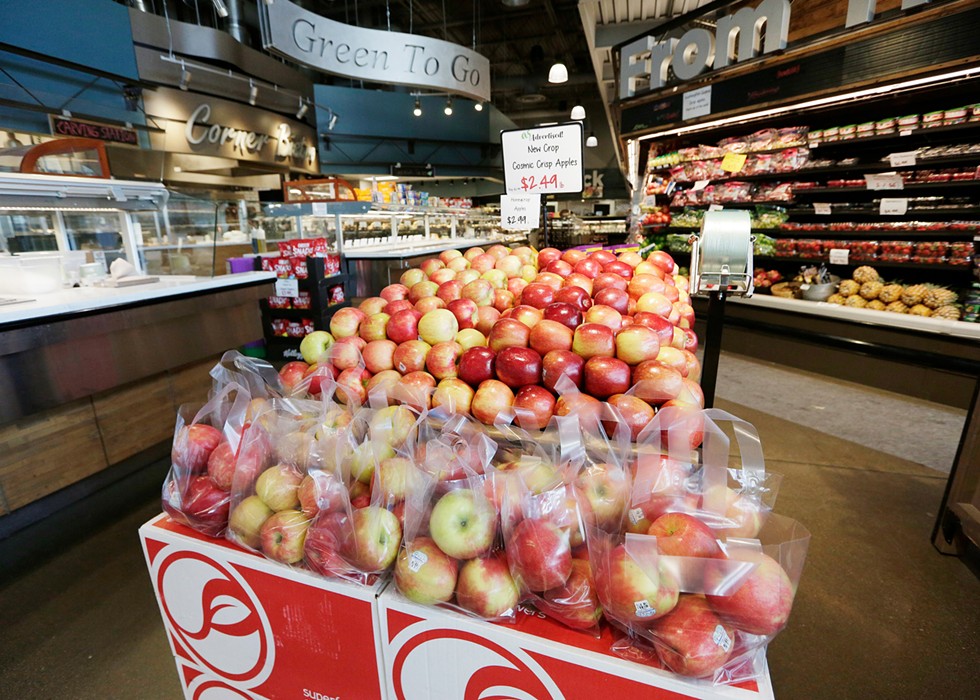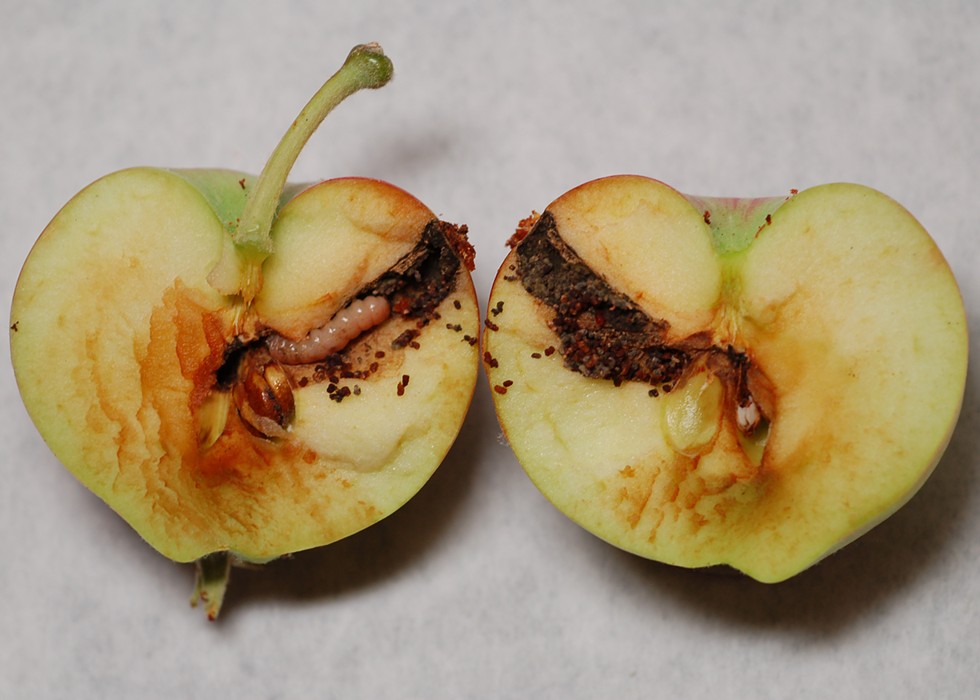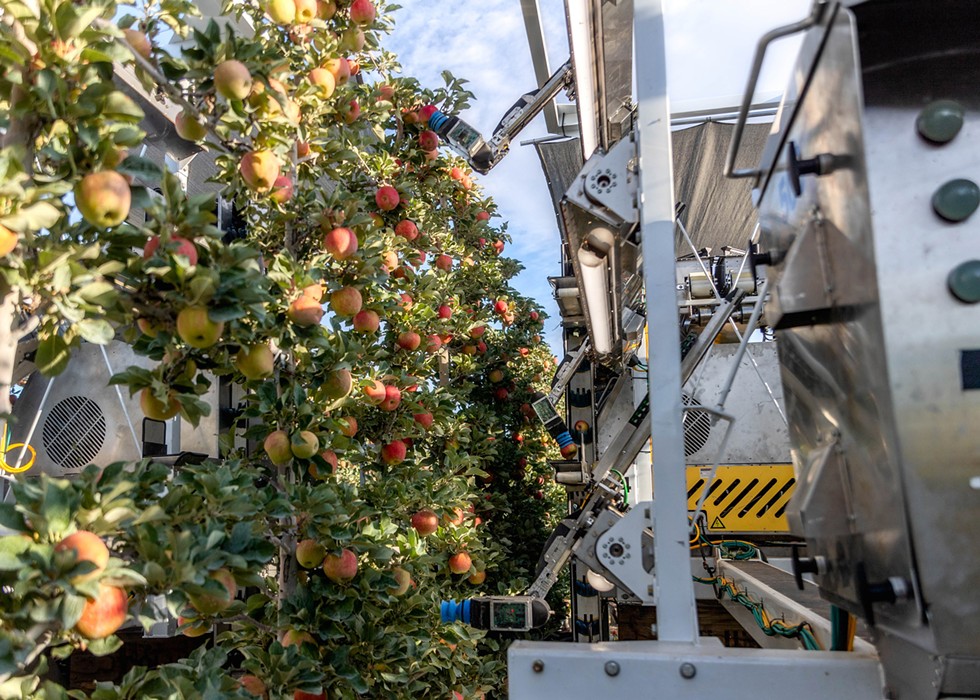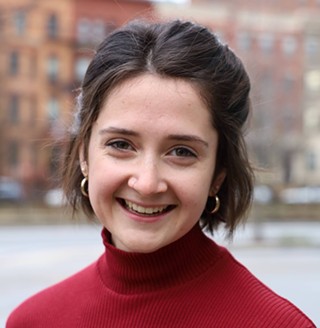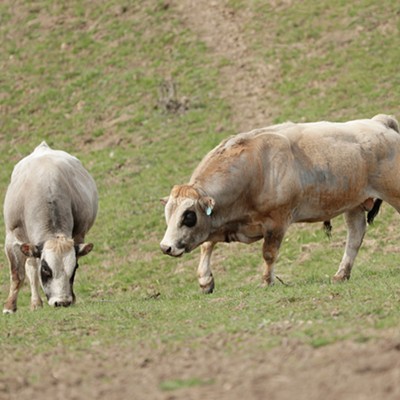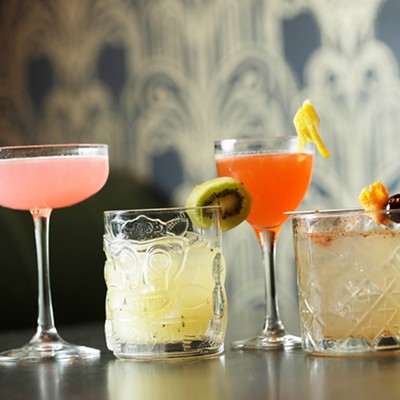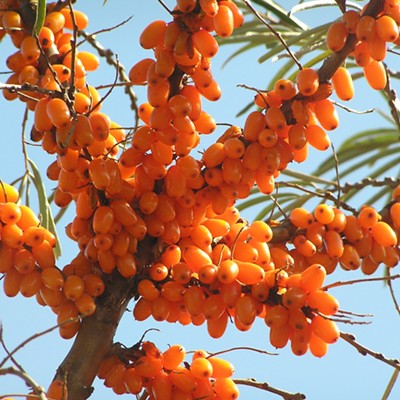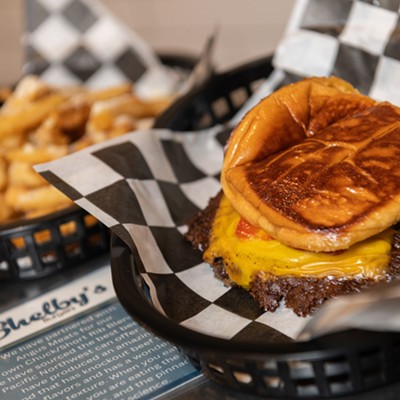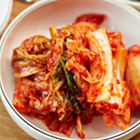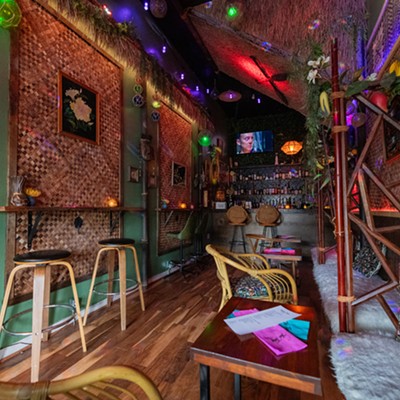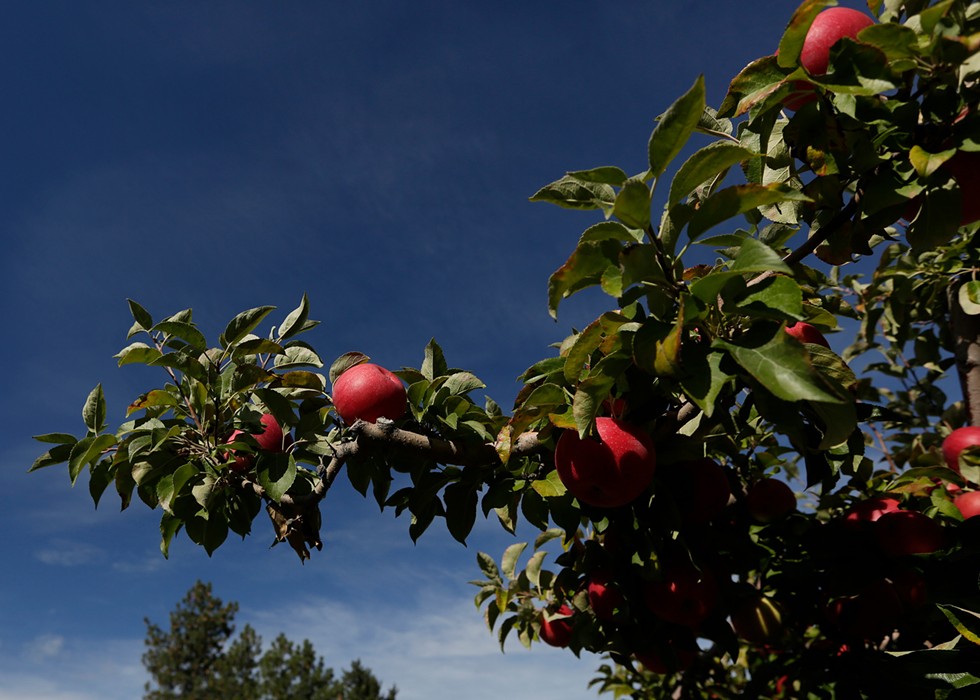
I see them on the ground first. Beside the Trail of the Coeur d'Alenes just south of the Harrison Marina, piles of wild apples decaying in the dirt, too heavy for the already bowing branches.
I scan the tree for a snack. Starting from the outside, I spin each apple to check for worms. Most are spoiled. I keep searching until I'm shoulder deep in the tree. Finally, I find a few untouched fruits, firm and blushed with a purplish pink, and draw them out, carefully unthreading myself from the branches.
I pause to behold my prize and think of Henry David Thoreau, who celebrated the wild apple and the effort it takes to eat them.
"Such always is the pursuit of knowledge," he wrote in The Atlantic. "The celestial fruits, the golden apples of the Hesperides, are ever guarded by a hundred-headed dragon which never sleeps, so that it is a Herculean labor to pluck them."
Thoreau's apples are crabapples, the only malus species native to North America. Washington's first Malus pumila, a much-favored sweet apple tree, was planted in 1826. Legend has it that a young English soldier brought apple seeds gifted from a long-lost love to his new post at Fort Vancouver. This tree, at 194 years old, died just three years ago. It witnessed a symbol of young love blossom into a multibillion-dollar industry.
Amanda L. Van Lanen, a historian at Lewiston's Lewis-Clark State College, traces how Washington supplanted New York as the nation's leading apple producer in her recent book, The Washington Apple. The young Western state was coming of age at the same time agriculture was shifting from subsistence to commercial, railroads were connecting markets in big cities, and scientists were improving pesticides and mechanical sprayers. The home of the Big Apple lost its lead due to climate advantages and timely technological advances in the Northwest — but also to relentless marketing.
In 1937, the state Legislature formed the Washington Apple Commission (initially titled the Washington State Apple Advertising Commission). Its sole purpose was to create campaigns and merchandise that promoted Washington apples as the best apples both domestically and internationally.
The advertising commission set a new standard for marketing fresh produce. Magazine ads touted "The Health Fruit." The American Dental Association dubbed the apple "Nature's Toothbrush." And grocers built huge apple displays to compete for prizes like watches, boats or, in one case, a 1965 Ford Thunderbird.
In a 1970s TV advertisement, a disembodied voice sings to classical guitar during golden hour in an orchard: "Washington apple, the beautiful fruit — for beautiful people to share."
The camera pans to a man and woman walking together through the garden. She's picked an apple from a nearby tree. She takes a bite. If the song is correct, she'll offer the next bite to her partner. The only thing missing is a snake.
Apples became shorthand for health and happiness. The fruit epitomizes love, lust and luxury everywhere from Sunday school classrooms, fairy tales and Greek mythology to Shel Silverstein, Steve Jobs and the Beatles. Apples, we're told, are so beautiful that they could easily tempt Snow White to trust an old hag or Eve to disobey God. (Though the fruit in Eden is never actually specified in the Hebrew text, and could have easily been a pomegranate or a fig.)
We live into this nostalgia, taking Instagram selfies in autumnal u-pick orchards or fussing over the prettiest fruit from the grocery aisle. My family used to sing a song about Johnny Appleseed to bless our meal.
But as our nostalgia grows, so does the industry tasked with producing this emblematic fruit. Turns out, it's scientists, bugs and robots who create the fruit we've come to expect. Outside of Eden, data analysts plan the exact permutations that separate a puny crabapple from a profitable Honeycrisp. Growers are caught in an intensifying arms race to keep worms out of our afternoon snack. Artificial intelligence trains robots to harvest walls of fruit.
Washington's love affair with apples has turned into a full-on, industrial-scale obsession.
TIME TRAVELERS
Amit Dhingra is a fruit guy.
The soft-spoken professor grew up in India during the 1970s and '80s when food was scarce and deaths from hunger were common. He is now the head of horticultural studies at Texas A&M University and a geneticist whose bio includes intimidating words like "transcriptomics," "chloroplast genomics," and "plastid transformation." But at his core, he's a poet who talks about how apples "can bring people together despite their differences."
Dhingra also operates a genomics research lab at Washington State University. A few years ago, he heard about David Benscoter, an ex-CIA agent who was hunting down lost apple varieties in the Palouse. In 2015, Benscoter rediscovered a "Nero" variety on Steptoe Butte about 50 miles south of Spokane, an apple previously thought to be extinct. Since then, he and other volunteers have found 29 "lost" apple varieties across Eastern Washington, Oregon and North Idaho.
When Dhingra heard about a group of volunteers cataloging heritage apples, he was thrilled in the way only a geneticist could be. He imagined families going into their backyards to study apple genetics, find old species and, maybe, create new ones.
"I thought, 'This would be so cool,'" he says. "A publicly sourced, multigenerational apple breeding program."
Dhingra started working with Benscoter's Lost Apple Project, a nonprofit dedicated to identifying, preserving and reintroducing heritage apple trees. They fielded calls from people curious about old fruit trees in their backyards. Dhingra's genetic research allowed him to travel back in time, rediscovering not only the apple's identity, but the weather conditions and migratory patterns hidden within the apple's genome.
Dhingra thought he would spend lots of time outside. But by searching for lost apples, Dhingra found himself at kitchen tables and in living rooms instead. He heard stories of a childhood swing, a wedding or a grandmother's recipe. The people calling the Lost Apple Project were less interested in mapping genomes and more interested in sharing their family lore. The project became a collection of oral histories, more often preserving human history than apples.
The apples Dhingra and Benscoter found were usually ugly — though sentimental owners might disagree. Ugly apples are pretty useless to current apple breeding programs, says Kate Evans, a plant breeder at WSU. Evans is a co-creator of the Cosmic Crisp, an apple released to consumers in 2019 that was bred to improve on the popular Honeycrisp apple. In its first four years, Cosmic Crisp has become the seventh-best selling apple in the U.S., trailing industry standards like Gala and Fuji, but eclipsing traditional favorites like Ambrosia and McIntosh.
The apple epitomizes love, lust and luxury everywhere from Sunday school classrooms, fairy tales and Greek mythology to Shel Silverstein, Steve Jobs and the Beatles.
tweet this
Evans is a transplant herself from England and perhaps as responsible for the success of Washington's apple industry as Fort Vancouver's 194-year-old tree.
She says that a breeder's job is to produce more and more varieties of apples that are beautiful and delicious. It's true that an ancient apple might have one desirable trait, like drought resistance, but it probably has far more undesirable ones, like size, color, texture or taste.
"It's bringing in all these negative traits that, in fact, we have to select out," Evans says. Selecting traits out can take decades. Quicker than the centuries it might take in the wild, but still a long time to wait.
"There's really got to be a reason to do it," she says. "I will do it. But it also depends, honestly, at what point in your career you are. Anything that I do now, I'm not going to taste the fruit."
Evans isn't much past middle age, with short-cropped hair and a youthful, light step. But she already knows that her current work will serve the next generation of Washington growers. Their apples need to be marketable, and supermarkets are ruthless judges.
Apples are graded on color, shape, sugar level, crispness and condition. Washington Extra Fancy is the highest grade, because Washington holds its apples to a higher standard than the rest of the U.S. A major Washington distinguisher is a stricter definition of a "good shade of red."
Psychologists, advertisers and plant breeders know that red is a powerful color. The fruit in Eve's mouth is almost always red. Snow White's poison apple is blood red. (Red is associated with both love and malice, and the Latin malus can mean either evil or apple. A translation error is probably what drove Christendom to read apples into Eden.)
Red is so powerful, it's a big reason the Red Delicious still exists. Red Delicious is an awful apple — waxy skin and mealy, flavorless flesh that browns immediately. But on the outside, they are bewitching.
Evans suspects that Red Delicious were bred for their color alone. From an eating perspective, "just because you're selecting something red doesn't necessarily mean that it's better."
But consumers eat — and shop — with their eyes first. Red Delicious is stereotypical Barbie, exactly what you think of when you think "apple."
In order for an apple to make it to the produce section, especially in Washington, it needs to have lots of red. Plant breeders like Evans know this. As they breed new varieties or improve on old ones, they now know to hone in on flavor, but they also look for the most colorful fruit. So keep an eye on your favorite apple varieties. Thanks to strategic breeding, Galas, Fujis, Pink Ladies, Honeycrisps and Cosmic Crisps are likely to turn redder and redder.
LATE NIGHT SNACKS AND SAFE SEX
In the cover of night, an earwig lurks along an apple tree branch. It feels its way to a cottony, pea-sized ball of fluff stuck to the base of a leaf. The earwig tickles it with its antennae, then sinks its mandibles into the white fuzz and devours it in 20 minutes. OK, not super speedy, but earwig mouths are pretty small.
This episode, caught on a special night-vision camera, is one of the best things to happen to WSU entomologists Robert Orpet and Katlyn Catron. It proves that earwigs eat wooly apple aphids, the tiny insects that spew white "wool" from their abdomens and make young apple trees susceptible to a deadly fungus.
These aphids are hard to kill, especially once they move underground to feast on a tree's roots. Apple growers need to kill as many aphids as possible while they're above ground. But spraying lots of chemicals is unattractive for multiple reasons — it's expensive and off-putting to consumers, but it's also an acceleration toward insecticide-immune super aphids.
A successful insecticide will kill most of the insects it targets. But inevitably, a few will survive. These survivors are more resistant to that insecticide, and as they reproduce, they pass that resistance to their progeny. If the same insecticide is used on them, their resistance only grows stronger.
In a few generations (and insect generations can be as quick as a few months), most of these pests — the survivors' offspring — are suddenly resistant to a chemical that was perfectly potent before. It's a trend nicknamed the "pesticide treadmill."
So when WSU got a video of an earwig's gory late night snack, they had visual proof of a potential off-ramp from that treacherous treadmill. To test their idea, they asked Wenatchee orchardists to host a colony of earwigs for an all-you-can-eat buffet.
This is no small ask, considering earwigs' reputation. Most people start squirming as soon as they imagine an earwig burrowing into their ear canal (an awful myth first penned by the ancient scholar Pliny the Elder, who also thought that caterpillars grew from dewdrops on radish leaves).
A more relevant concern is for the fruit itself. Earwigs are pests in peach and apricot orchards, where they chomp on the fleshy fruit. Would earwigs eat aphids or apples?
Orpet discovered that earwigs can't bite into an apple's relatively tough peel. They could be trusted to roam freely about the orchard, preying on aphids without being tempted by the luxurious fruit itself.
Armed with Orpet's discovery, Catron set to work coordinating the Earwig Transit Project. She gathered 10,000 earwigs from peach orchards and divided them into plastic buckets of 500 each, throwing in some dog kibble and spinach for food.
On a Wednesday morning in July, Catron pitched a tent at the arid WSU Tree Fruit Research & Extension campus, stocking it with water, snacks and merch, like notepads branded with an "Earwig Transit Project'" logo and cute cartoon earwigs. She spread out folders containing relevant research notes, but also some fun facts to make the bucket of 500 earwigs less horrifying.
She assured hesitant growers that earwigs aren't scary, but actually one of the only insects to show maternal care. She explained that the long "pincers" on an earwig are actually their butts, and those intimidating genitals have more endearing spin in other languages — the Spanish name for earwigs, tijeretas, means "little scissors." Growers were educated and entertained. All the buckets were taken home. So in a few years, when you eat an apple grown on a healthy, aphid-less tree, you might thank those cute little scissorbutts for cutting fuzzy mutants out of your life.
Aphids are one of many pests that want to gorge themselves on an apple orchard, and though they're problematic, they're not the worst. The archnemesis of apple growers, which has been plaguing orchardists for centuries, not only wreaks havoc on crops, but has somehow endeared itself to school-age children the way few other bugs have.
If you've ever been in an elementary school, you've seen clip art images of a green worm poking its head out of an apple, smiling and wearing glasses or a graduation cap, sometimes even holding a book.
But worms don't eat apples. Codling moth larvae do. Codling moths are the sworn enemy of Washington apple growers. An adult moth lays its egg on the outside of the fruit, and when it hatches, the baby munches its way toward the seeds of the apple, which are the most nutritious for a growing grub. The larvae grow unseen inside the fruit until an unsuspecting eater comes along and gets a mouthful of grub guts with their first bite.
Apples and codling moths are native to the Middle East. The moths followed apples to North America, but the parasitoids that prey on the moths never made it. In Washington, the most common way to kill codling moths is trying to spray an insecticide at the exact right time: the few days when the majority of eggs have been laid, but the fewest larvae have hatched. This is a very hard window to pinpoint.
But WSU entomologist Rob Curtiss is researching a new way to minimize both insecticide use and worm-infested apples. If his tactics catch on, your larvae-less apples could be the result of discrete manipulation of a moth's sex life.
Curtiss is one of the only people in his department without a nose piercing or beetle tattoo. He has a short beard, no-rim glasses, and research experience in upstate New York, Michigan, British Columbia and Hawaii. For a two-year grant project at WSU, Curtiss decided not to kill codling moths. Instead, he breeds them. The closets in his laboratory are full of humidifiers and mesh habitats, with larvae growing in seedling trays, their white bodies bulging from kidney bean mush.
Curtiss thinks that more moths could be the key to less larvae, ironically. That's because his moths are sterile — they can't lay eggs. Curtiss is researching various mating disruption techniques to manage codling moth populations. One idea is to release a colony of sterilized moths into an orchard and let them do what the birds and bees do. The more often an unsuspecting moth mates with a sterile moth, the fewer eggs are made. Sterilized moths could be a clever, chemical-less way to counteract reproduction, while still letting moths, but not eggs, get laid.
But it's hard to convince growers that more moths flying around the orchard could be good for their crop. Growers usually set traps for moths and estimate the total number of moths in their orchard from the amount they catch. More moths equal more pesticides. But with Curtiss' proposed method, orchardists need to be able identify which moths are dangerous and which are sterile.
Curtiss sprays his sterilized moths with a fluorescent dye powder. He converted a laboratory closet that's not a codling moth nursery into a darkroom. Under the soft purple light, he can count how many trapped codling moths are his. Since the dye is only visible under ultraviolet light, it's not like apple orchards will suddenly flutter with glowing moths, though "I think my growers would really like that more," Curtiss chuckles.
It will take at least two years to nurture a self-sustaining colony of codling moths that can be loaned out to orchards, Curtiss says. While he works to keep his baby grubs happy, he also tries to spread the word to elementary schools that there aren't any actual worms in apples, codling moth larvae aren't green, and they definitely can't read.
JUMPING INTO HYPERSPACE
Unlike Thoreau, most people don't like the "Herculean labor"of picking wild apples. As Washington homesteaders planted new lives for themselves in the Northwest, they organized their fruit trees into orchards. They planned rows and pruned branches so the fruit was plumper and easier to pick. On Greenbluff just northeast of Spokane, u-pick orchards do the same. Apples are easy for toddlers to see and simple for adults to pluck.
But commercial orchards take it a step further. They tuck and trim trees into "fruit walls," two-dimensional, vertical planes that make it even easier to see and pick fruit. Fruit walls also make it easier for agriculture to transition to its next chapter: robots.
Ag tech companies are always working to automate hard tasks. For years, small self-propelled vehicles with names like "Bandit Cyclone" have rolled through rows of fruit walls. Harvesters stand on various platforms at different heights, stripping the wall bare without climbing ladders and using as few strokes as possible. But ag tech's next challenge is to build a completely automated harvester that eliminates the need to carry human harvesters at all.
Automation is not new. The Palouse is used to seeing huge combines harvest wheat and barley. But automating fruit crop harvest is much harder. Picking apples professionally requires an eye for ripeness, a surgical flick of the wrist, and a quick but controlled delivery.
A human apple harvester is a highly desired, highly skilled employee. Many harvesters travel from Mexico on temporary H-2A visas. According to the Washington Apple Commission, peak harvest season in Washington requires about 40,000 workers to harvest 10 to 12 billion apples every year. There aren't enough people in rural areas to pick, even if everyone was willing to do the hard labor. Growers are willing to set up temporary towns for valuable employees traveling from far away.
But aligning the harvest with the harvesters isn't easy.
"About every other year, we'll have a one- to four-week period where we have a labor shortage," says West Mathison of Stemilt Growers, a fifth-generation family-owned fruit company in Wenatchee. "We'd like harvest to be very linear. But that's just not the way the fruit matures in Mother Nature."
Rain, heat, immigration policy and labor regulations, plus unforeseen issues like pandemics, interrupt workers. But the work remains. Diversifying harvesting options with robots could help stabilize the harvest season, especially if robots can offer helping hands when humans can't.
Critics worry that human jobs are continuing to be sacrificed at the altar of artificial intelligence. Stemilt is a leader in fair farmworker treatment — it was the first tree fruit grower, packer and shipper to reach full certification from the Equitable Food Initiative, an organization committed to safety, health and transparency in food systems. As president of Stemilt, Mathison wonders if robots could bear the brunt of hard labor while paving the way to higher quality jobs for human counterparts.
"The real successful technologies are the ones that have that really smooth interfaces, to where the person who is doing [a job] manually the week before can transition into really overseeing that piece of technology," Mathison says.
But a robot takeover is unlikely. "Just because of the nature of the work, some percentage of the fruit will always be harvested by hand," he says.
Apple harvesting robots are still in heavy training, and ag tech companies are competing to design the most successful model. Some robots have drones that fly into the canopy and pull out fruit with long suction cup noses. A robotic harvester from advanced.farm, an ag tech start up in Northern California, has six arms that move independently. Each arm scans the foliage with camera "eyes," trained on hours of photo slideshows. When it sees a ripe apple, it latches onto it with a soft suction cup and twists.
"What we're doing does have an element of sci-fi and an element of futuristic technology," says Peter Ferguson, director of business development at advanced.farm. "That's exciting. We're using artificial intelligence and very revolutionary technologies to do what we're doing."
Sometimes the robot breaks off a small part of the branch along with the apple. Sometimes it doesn't grab anything at all. The cameras may only recognize half of the ripe apples. Eight years ago, when Mathison took his kids along with him to see an early-stage robot harvester, his then-7-year-old daughter was less than impressed.
"She looks at me, and she goes, 'You drove us all the way out here just to show us that?'" he says. "We shouldn't overestimate what we're gonna accomplish in the next one to two years. But we shouldn't underestimate what we can evolve to over the next five to 10. The first time they jumped to hyperspace in Star Wars, I'm sure it didn't go that well either."
I wonder if any robot in the near or far future could pluck the three apples I managed to wrangle out of the tree on the Trail of the Coeur d'Alenes.
This apple would never make it to a grocery store shelf or even to a plant breeder's lab. But it was my first wild apple, and I fell in love.
tweet this
I took one more moment to gaze at my hard-won fruit, somehow unbothered by moth or modernization. Finally, my first bite. The apple flesh was pure white, but browned immediately. It was crisp but a little chalky, and tasted like a pear, sweet and floral with almost no tang. The skin didn't have much red on it. This apple would never make it to a grocery store shelf or even to a plant breeder's lab. But it was my first wild apple, and I fell in love. If anyone ever abandoned me for some distant shore, I might ask him to remember me with a fruit like this.
So I have to side with Thoreau on this one — it was definitely worth the work. ♦

